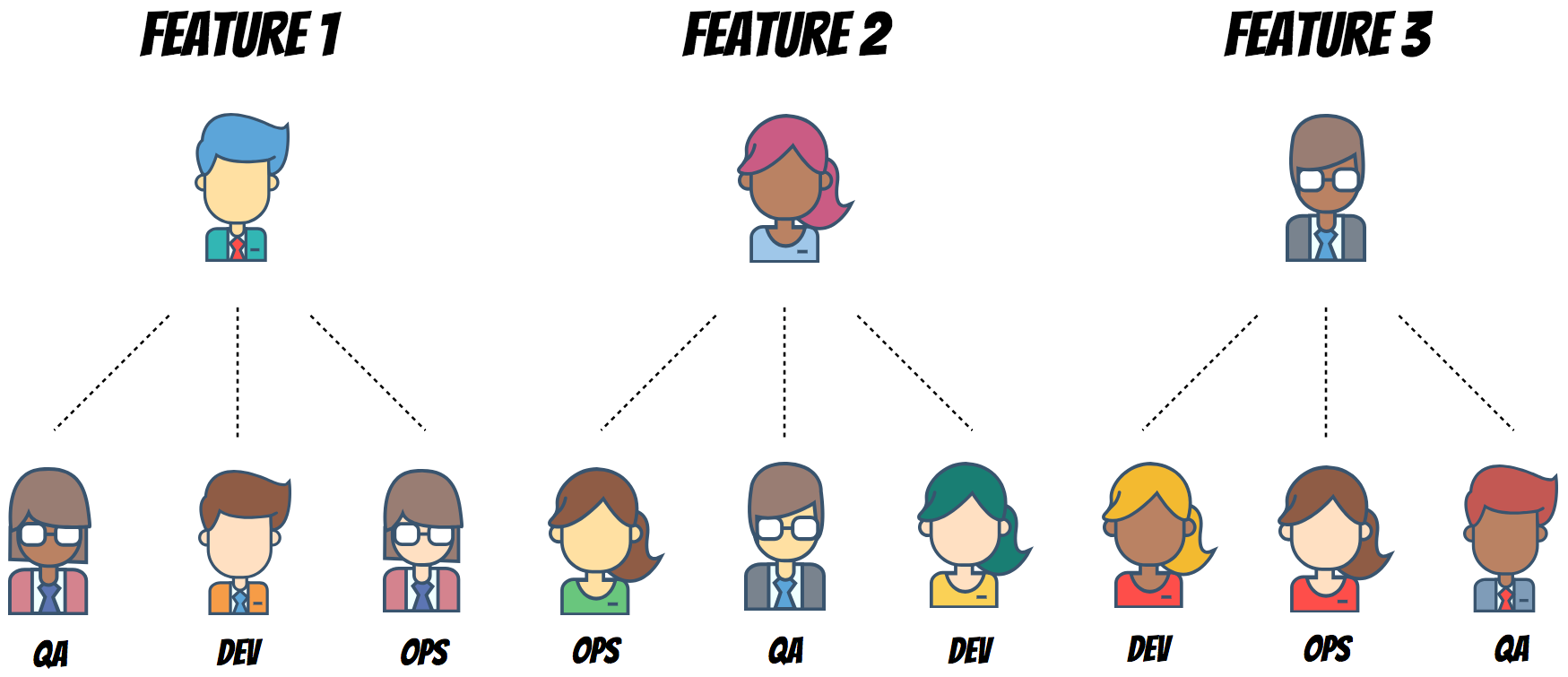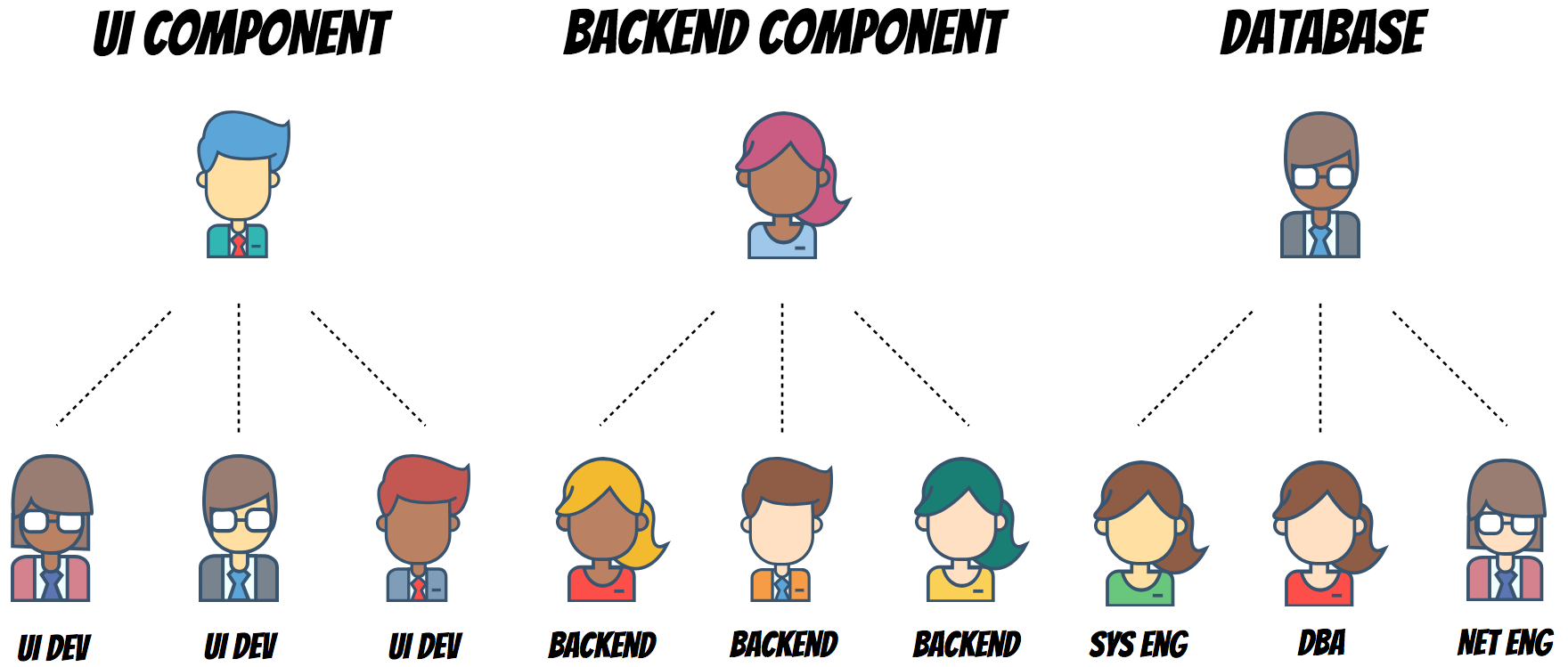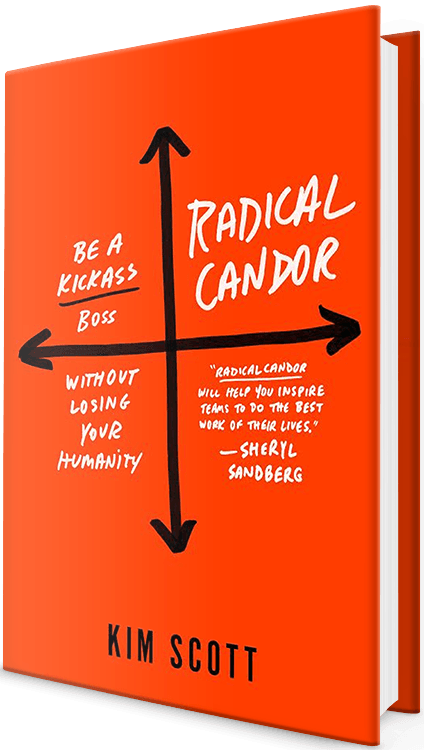Almost every aspect of a software development organization is influenced by whether the people of the organization have a fixed or a growth mindset. This includes the design of the organization itself, its culture, how it adapts to change, and how people within that organization communicate, manage, measure, motivate, hire and fire.
Organization Design
It all starts with the design of the organization. Is it composed of self-managing, self-organizing, cross-functional teams or siloed, hierarchical, command-and-control fiefdoms?
Cross-Functional Feature Teams
Single-Function Component Teams
If you have a growth mindset, you are comfortable with failure and you are willing to risk giving people authority to do things they aren’t yet skilled at. You can take the risk of delegating decision-making authority, resulting in teams that are self-managing and self-organizing. You expect those teams to be comprised of people who can learn to work effectively with people outside their silo and learn skills they didn’t have when they entered the organization, resulting in cross-functional, collaborative feature teams instead of siloed, contract-negotiating component teams. You structure your organization for learning rather than for avoiding failure.
Culture
The culture of such organizations is healthy. It welcomes new ideas from anywhere inside and outside the organization and is willing to try new things and take risks because that’s how we learn. It does not subscribe to the “not-invented-here” philosophy. Such an organization is not only open to diverse ideas but open to a diversity in its people. Each role in the organization has a respect for the other roles rather than having the elitism associated with some parts of the tech world.
Adaptability To Change
When such an organization needs to respond to changes in the market by changing itself, it is ready. Adopting new principles and practices like those of agile frameworks like XP, Scrum, Lean, and Kanban or developing a DevOps mentality comes naturally to such organizations because change is welcomed as growth. Fixed mindset organizations don’t believe they need to change, even when the market is telling them otherwise. Why? Because they can place the blame anywhere but on themselves.
Communication
Mindset also determines how organizations communicate internally. Fixed mindset organizations give feedback differently from growth mindset organizations. People in fixed mindset organizations, regardless of their own mindset, sometimes withhold criticism to prevent ego damage and get along. They know the organization will use criticism as a stick instead of for growth, so they keep it to themselves. Fixed mindset organizations praise talent and intelligence, perpetuating the fixed mindset. Want to get out of this trap? Take a look at the book Radical Candor by Kim Scott.
People in fixed mindset organizations complain and blame and fail to see the role they had in a situation.
A fixed mindset organization tends to create dominant personalities that need to look smart and submissive personalities that need to avoid looking stupid. So you get conflict avoidance and you miss out on constructive debate. At growth mindset organizations, curiosity drives people, nobody needs to look smart or cares whether they look stupid. People are happy to have a debate simply for the learning that comes out of it.
Management
What does a manager at a fixed mindset company look like? They can’t take feedback about themselves, especially from subordinates. If they started as engineers, they likely saw their own transition into management as a promotion rather than a lateral move. They think, “I know best, that’s why I have this job,” rather than, “I don’t have all the answers and ideas. Let’s work together.” Some of them have an inability to delegate because they can’t let go of being the engineer with all the answers and they stick with first impressions both positive and negative and pigeonhole their subordinates into roles with strictly-defined duties.
Measurement
Mindset also plays a role in how you evaluate people and what you do with those evaluations. Measuring someone for the purpose of giving that measurement data directly to the person to help them grow is different from measuring someone to reward or punish them.
Using velocity to measure teams against one another is a particularly unhelpful practice that appeals to a fixed mindset, eager to measure for rewarding and punishing and not eager to really learn anything. Code coverage is another metric to help guide a team in how they test their software, but setting company-wide code coverage minimums just triggers shallow coverage as people write tests that boost coverage but don’t actually test anything.
Juking the stats or gaming the measurement is a very fixed mindset idea. If you wanted to use the measurement to actually learn something, you wouldn’t choose to game it. But the gaming of metrics is so common that we have Goodhart’s Law, which states, “When a measure becomes a target, it ceases to be a good measure.”
Motivation
We measure so that we can give people feedback on their performance but even this can become a victim of the fixed mindset. Look at how career ladders are often structured in fixed mindset organizations – they reflect a hierarchical division of labor where architects design and engineers implement. The only path upward on such a ladder is through gaining more and more domain expertise. There is little to gain in taking work outside your area of expertise, which discourages cross-discipline skill growth.
Hiring and Firing
This appears again in how fixed mindset companies do their hiring. They hire experts who will stay in their lane. Growth mindset companies hire T-shaped people who can become experts in new disciplines. The interview processes at fixed mindset companies further enforces the fixed mindset: people hire people just like them. They don’t hire people who are so good they make them look bad and interviews become hazing rituals where the interviewer shows off their own knowledge instead of evaluating the candidate.
Everywhere you look in a fixed mindset company, you see the signs of the fixed mindset. But if you look carefully, you may also see opportunities for the growth mindset to take its place.
I would love to hear what you thought of the video, so feel free to comment below, on The K Guy Twitter, or on The K Guy Facebook fan page.


Pingback: Mindset And The Agile Manifesto - The K Guy()